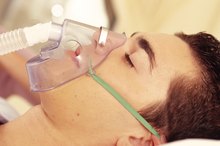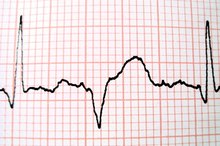How to Understand Dialysis Readings on the Machine
People who suffer from end stage renal disease must receive dialysis on a routine basis to replace the function of their nonworking kidneys. A dialysis machine is a delivery system for the fluids and artificial kidney that helps to cleanse the patient’s blood and remove excess fluid from their body. These machines are intended for use by trained personnel only. At first glance, dialysis machines may appear intimidating due to all of the readings, displays and buttons. However, approaching the operation of the machine in a systematic manner makes it much easier for the layperson to understand.
Instructions
Locate the blood flow rate (BFR) display near the spinning blood pump. The BFR represents the speed that the patient’s blood is moving through the dialysis tubing. The number displayed is typically set between 250 and 500 milliliters (mL) per minute (min).
Equipment for Checking Blood Pressure
Learn More
Locate the arterial and venous vascular access pressures on the control panel. These pressures are normally displayed above a pressure scale in units of millimeters of Mercury (mmHg). The arterial pressure is a negative, or vacuum type pressure that represents the amount of force required to remove the patient’s blood from their body. The venous pressure is the force exerted by the blood pump while returning the blood to the patient.
Locate the following ultrafiltration (UF) controls: UF goal, UF time, UF rate, and UF removed. The UF goal is the total amount of fluid in mL to be removed from the patient during the dialysis treatment. The UF time is the amount of time over which the fluid will be pulled from the patient. The UF rate is the rate at which the fluid will be pulled from the patient, represented in mL per hour (hr). The UF removed is the amount of fluid in mL that has been removed from the patient thus far in the treatment.
How to Irrigate Foley Catheters
Learn More
Locate the dialysate flow display on the control panel. The dialysate flow is the rate in mL/min that the dialysate (dialysis fluid) is moving through the dialyzer (artificial kidney). The dialysate flow rate can be set anywhere between 300 and 1,000 mL/min.
Locate the temperature reading on the control panel. This is the temperature of the dialysate in degrees Celsius. Normally the dialysate temperature is set at about 37 degrees Celsius.
Locate the remaining time on dialysis (RTD) on the control panel. The time displayed is equal to the amount of time the patient has left in the dialysis treatment.
Locate the transmembrane pressure (TMP) and vital sign readings on the control panel. The TMP is a measurement of the pressure differential between the pressure of the blood and dialysate compartments within the dialyzer. The blood pressure and heart rate displays give information about the patient’s vital signs throughout the duration of the treatment.
Tips
Low blood pressure readings may indicate that too much fluid has been removed from the patient too quickly. A trained operator of the machine may determine that the patient needs to receive replacement fluid.
High arterial pressures typically mean that there is a problem with blood flow from the patient’s blood access, or there is a kink in the blood tubing between the patient and the blood pump.
High TMP readings may indicate that blood clotting is present in the dialyzer. Flushing the dialyzer with saline may reduce the TMP to a normal range.
Catheters typically have lower blood flow rates than do other types of blood accesses.
Warnings
All of the items discussed within this article are prescriptions made by a nephrologist (kidney doctor), intended to be carried out by trained medical professionals. Therefore, no modifications should be made to these prescription items unless under the supervision of a trained medical professional.
- Locate the blood flow rate (BFR) display near the spinning blood pump.
- The UF rate is the rate at which the fluid will be pulled from the patient, represented in mL per hour (hr).
- Locate the transmembrane pressure (TMP) and vital sign readings on the control panel.
Related Articles
References
- DaVita
- National Kidney Foundation. Quick reference guide on kidney disease screening.
- U.S. National Library of Medicine, MedlinePlus. Chronic kidney disease. Updated August 1, 2017.
- National Institute of Diabetes and Digestive and Kidney Diseases. Your kidneys and how they work. Updated June 2018.
- National Institute of Diabetes and Digestive and Kidney Diseases. Hemodialysis. Updated January 2018.
- National Kidney Foundation. Your dialysis care team. 2015.
- National Institute of Diabetes and Digestive and Kidney Diseases. Peritoneal dialysis. Updated January 2018.
- Zee J, Zhao J, Subramanian L, et al. Perceptions about the dialysis modality decision process among peritoneal dialysis and in-center hemodialysis patients. BMC Nephrol. 2018;19(1):298. doi:10.1186/s12882-018-1096-x
Tips
- Low blood pressure readings may indicate that too much fluid has been removed from the patient too quickly. A trained operator of the machine may determine that the patient needs to receive replacement fluid.
- High arterial pressures typically mean that there is a problem with blood flow from the patient’s blood access, or there is a kink in the blood tubing between the patient and the blood pump.
- High TMP readings may indicate that blood clotting is present in the dialyzer. Flushing the dialyzer with saline may reduce the TMP to a normal range.
- Catheters typically have lower blood flow rates than do other types of blood accesses.
Warnings
- All of the items discussed within this article are prescriptions made by a nephrologist (kidney doctor), intended to be carried out by trained medical professionals. Therefore, no modifications should be made to these prescription items unless under the supervision of a trained medical professional.







